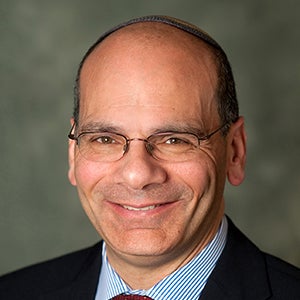May 10, 2016
On a recent Shabbat afternoon in Warsaw, I walked through the shadows of a Jewish horror show: first, remnant slivers of the wall of the Warsaw Ghetto in someone else’s apartment courtyard; then the site where once stood the majestic Great Synagogue the Nazis destroyed after they suppressed the Ghetto Uprising; next, the outline of the bridge that connected the larger and smaller sections of the ghetto; on to an imposing memorial listing 448 Jewish first names at the Umschlagplatz, from where Warsaw’s Jews were transported on a one-way journey to Treblinka; and, finally, a mass-grave memorial to the victims, adjacent to a huge Jewish cemetery where pre-Shoah giants of Jewish history lie.
I was in Poland with an AJC delegation for the International Jewish Committee for Interreligious Consultations’ (IJCIC) biennial meeting with the Vatican’s Commission on Religious Relations with the Jews. Together, we visited Treblinka, an essential stop for Catholics and Jews. Our path to reconciliation must address a Shoah facilitated by two millennia of Christian anti-Jewish teachings and violence. The Nazis destroyed Treblinka as they fled. It is now filled with hundreds, perhaps thousands, of memorial stones of different sizes and shapes, symbolizing the diversity of the hundreds of thousands of Jews exterminated there and their communities of origin. I stood by the stone of Bialystok, where my family once thrived.
We encountered at Treblinka and in Warsaw hundreds of young Israelis taking part in the pilgrimage program Israel’s government runs to help the younger generation understand how Israel’s creation in the wake of the Holocaust transformed the Jewish people. In Warsaw, the mile-long street named for the Uprising leader, Mordecai Anielewicz, symbolizes that turning point in Jewish history from powerlessness to power. Even on Shabbat, our Israeli brothers and sisters dominated the large memorial square at the end of the street, with its larger than life sculpture by Nathan Rapoport depicting the Uprising, and a smaller, less visible sculpture of a march to death with the Torah in hand.
There are more Israelis in the square than one can count: secular adult tourists eating their box dinners; three separate large groups of Israeli teenagers on their own Shabbat walks — boys with knitted kippot and tzizit flying, Orthodox religious Zionist girls in their modest attire, and coed secularists. On this Shabbat, the square’s visitors include students of NFTY-EIE, the American Reform movement’s high school semester program in Israel. They are sitting on the steps of the memorial, at the feet of the oversized Anielewicz, listening to the inspiring words of their group leader. She finishes, they rise, unfurl their Israeli flag, and sing “Hatikvah.” It is one of those life-searing Jewish moments, as the depths of the Shoah and the heights of Israel are laid out vividly. The power of Jewish resilience is on display, and hope reigns in a place of despair.
Much is new since I last visited Poland 25 years ago, when the doors to the outside world were beginning to open, and democracy was reinstated after 40 years of Soviet-imposed communism. It was not just the wind of those young Israeli and American Jews on a Shabbat afternoon that filled my sails. The new POLIN Museum of the History of Polish Jews also inspires as it completes the memorial square with its architectural majesty; inside are 1,000 years of Polish Jewish life, a model of scholarly integrity, compelling creativity, and state-of-the-art technology. Our group of Catholic and Jewish leaders had only two hours to experience the museum, but it beckons you to return. By telling the millennium-long story of Polish Jewish life, it serves as an antidote to the understandable dominance of the Shoah in Polish Jewish history.
Polish Jewry’s re-emergence today is also relatively new. To be sure, it is hardly likely that the community will ever amount to more than a remnant of its former magnitude; of 3.3 million Jewish souls, 90 percent were murdered by the Nazis as a great Jewish civilization was destroyed. But there is no mistaking the presence of a small but vibrant Jewish community.
I attended Friday-night services and a communal dinner at Warsaw’s Progressive Ec Chaim synagogue together with several dozen stalwarts, including quite a few younger adults, who sang traditional tunes exuberantly. On Shabbat morning, about 100 filled the Orthodox Nozyk synagogue — the only one of Warsaw’s 400 synagogues to survive the war — and celebrated a bar mitzvah. Yet, spoken or unspoken, some Polish Jews worry about the current government’s retreat from democracy and the potential for renewed antisemitism, even as they relish new opportunities for community building in a country now anchored in NATO and the European Union.
The Polish Jewish experience bittersweetly demonstrates the indestructibility of the Jewish people. The once-destroyed center of European Jewry is now a magnet for today’s dual centers of world Jewry — the U.S. and Israel — contributing to the nascent revival of Jewish life in Poland.
Rabbi Noam E. Marans is the American Jewish Committee’s director of interreligious and intergroup relations.
This article was originally published by New York Jewish Week.



